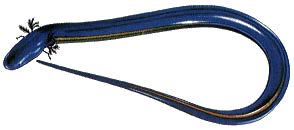Dwarf Siren

| Class: Amphibia:
Amphibians |
Diet: Small aquatic
invertibrates |
| Order:
Urodela: Newts and Salamanders |
| Size: 10
- 25 cm (4 - 9 3/4 in) |
| Family: Sirenidae:
Sirens |
Conservation Status:
Non-threatened |
| Scientific Name:
Pseudobranchus striatus |
Habitat: ponds, swamps,
ditches |
| Range:
USA: coastal plain of South Carolina, Georgia, Florida |
 The
smallest of its family, the dwarf siren is a slender, eel-like creature
which lives among dense, submerged vegetation. It has no hind limbs and
only tiny forelimbs, with three toes on each foot. The external gills are
retained throughout life. A nocturnal creature, the siren feeds on the
tiny invertebrate animals it finds among the plant debris near the bottom
of the water. If its habitat is in danger of drying up, as in a drought,
the siren can burrow into the mud and remain there, dormant, for up to
2 months. Mucus produced by skin glands prevents the body drying out during
such a period. The female lays her eggs, one at a time, on aquatic
plants, and the larvae hatch out about 4 weeks later. There are about 5
races of dwarf siren over the range, which vary in coloration and in the
shade and distribution of the stripes along the sides of the body. The
smallest of its family, the dwarf siren is a slender, eel-like creature
which lives among dense, submerged vegetation. It has no hind limbs and
only tiny forelimbs, with three toes on each foot. The external gills are
retained throughout life. A nocturnal creature, the siren feeds on the
tiny invertebrate animals it finds among the plant debris near the bottom
of the water. If its habitat is in danger of drying up, as in a drought,
the siren can burrow into the mud and remain there, dormant, for up to
2 months. Mucus produced by skin glands prevents the body drying out during
such a period. The female lays her eggs, one at a time, on aquatic
plants, and the larvae hatch out about 4 weeks later. There are about 5
races of dwarf siren over the range, which vary in coloration and in the
shade and distribution of the stripes along the sides of the body.

  
|
